英文报刊选读
英语报刊选读--参考答案
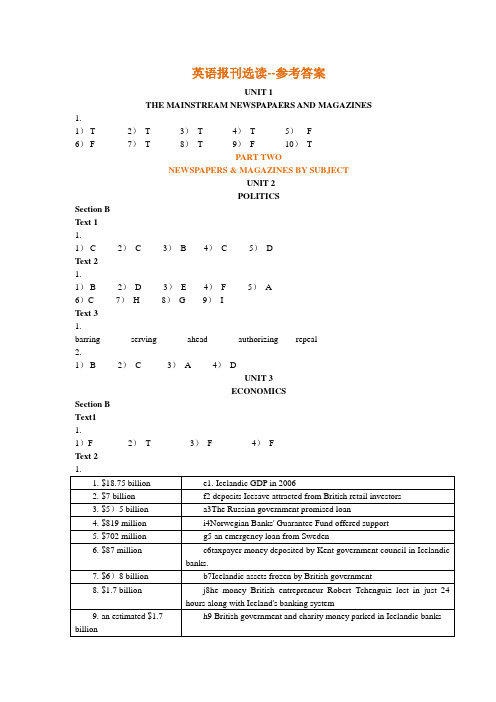
英语报刊选读--参考答案UNIT 1THE MAINSTREAM NEWSPAPAERS AND MAGAZINES 1.1)T 2)T 3)T 4)T 5) F6)F 7)T 8)T 9)F 10)TPART TWONEWSPAPERS & MAGAZINES BY SUBJECTUNIT 2POLITICSSection BText 11.1)C 2)C 3)B 4)C 5)DText 21.1)B 2)D 3)E 4)F 5)A6)C 7)H 8)G 9)IText 31.barring serving ahead authorizing repeal2.1)B 2)C 3)A 4)DUNIT 3ECONOMICSSection BText11.1)F 2)T 3)F 4)FText 21.1)T 2)F 3)F 4)T 5)TUNIT 4MILITARY AFFAIRSSection B1.1)A 2)D 3)B 4)DText 22.1)B 2)B 3)A 4)AText 33.1)D 2)D 3)B 4)BUNIT 5ENVIRONMENTSection BText 11.1)B 2)C 3)DText 21.1)i 2)g 3)m 4)k 5)j 6)d7)b 8)c 9)a 10)l 11)f 12)e 13)h Text 31.1)T 2)T 3)T 4)F 5)T 6)F 7)TUNIT 6EDUCATIONSection BText 1Section BText 11.1)B 2)DText 21.1)C 2)AText 31.1)F 2)T 3)T 4)FUNIT 7SPORTSSection BText 11.1)The author wants to analyze today's best athletes and shows sports fans what makes star athletes great.2)“The perfection point” refers to the limits of one's physical prowess.3)The Perfection Point is really about what are we as a species going to do as we try to achieve perfection.4)understood the motivation of the athletes using steroids and he was compassionate for them.Text 21.1)B 2)D 3) C 4) D 5) CText 31.1) T 2) F 3) F 4) F 5) T2.1)C 2)A 3) B 4) D 5) CUNIT 8ENTERTAINMENTSection BText 11.1) T 2)F 3)F 4)F 5)FText 21.1) F 2)F 3)F 4)T 5)F 6)TText 31.1) F 2)F 3)F 4)T 5)FUNIT 9BOOK REVIEWSSection BText 11.1) T 2) T 3) F 4) FPART THREENEWSPAPERS & MAGAZINES READINGS BY V ARIETYUNIT 10WEATHER FORECASTSText 11.1) A 2)B 3)10 KTS 4)1026Hpa, normal 5)2009/09/10,04:51 UTCText21.1) F 2) T2.Phoenix; Sunrise time is laterText31.78, Monday; 52, Wednesday3. Morning newspaper; because there is only low temperature on 13th, Sep., 2009)UNIT 11GRAPHICS(略)UNIT 12SHOWSSection BText 1Text 21. B2.1)F 2) FText 31.George Bernard Shaw (1856-1950) was born in Dublin, the son of a civil servant. His education was irregular, due to his dislike of any organized training. After working in an estate agent's office for a while he moved to London as a young man (1876), where he established himself as a leading music and theatre critic in the eighties and nineties and became a prominent member of the Fabian Society, for which he composed many pamphlets. He began his literary career as a novelist; as a fervent advocate of the new theatre of Ibsen (The Quintessence of Ibsenism, 1891) he decided to write plays in order to illustrate his criticism of the English stage. His earliest dramas were called appropriately Plays Pleasant and Unpleasant (1898). Among these, Widower's Houses and Mrs. Warren's Profession savagely attack social hypocrisy, while in plays such as Arms and the Man and The Man of Destiny the criticism is less fierce. Shaw's radical rationalism, his utter disregard of conventions, his keen dialectic interest and verbal wit often turn the stage into a forum of ideas, and nowhere more openly than in the famous discourses on the Life Force, «Don Juan in Hell», the third act of the dramatization of woman's love chase of man, Man and Superman (1903).2. The director is Doug Hughes, Sally Hawkins plays as Vivie Warren and Cherry Jones plays her mother Mrs. Kitty Warren.UNIT 13RELATIONSHIP ADVICESection BText 11.1) c 2)g 3)b 4)d 5)f 6)a 7)e Text 31. c 2)d 3)b 4)a 5)f 6)e。
英语报刊选读课程教学大纲
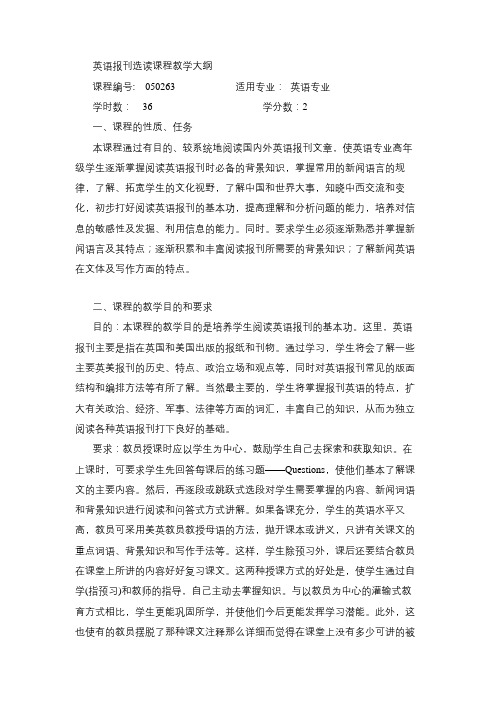
英语报刊选读课程教学大纲课程编号: 050263 适用专业:英语专业学时数:36学分数:2一、课程的性质、任务本课程通过有目的、较系统地阅读国内外英语报刊文章,使英语专业高年级学生逐渐掌握阅读英语报刊时必备的背景知识,掌握常用的新闻语言的规律,了解、拓宽学生的文化视野,了解中国和世界大事,知晓中西交流和变化,初步打好阅读英语报刊的基本功,提高理解和分析问题的能力,培养对信息的敏感性及发掘、利用信息的能力。
同时。
要求学生必须逐渐熟悉并掌握新闻语言及其特点;逐渐积累和丰富阅读报刊所需要的背景知识;了解新闻英语在文体及写作方面的特点。
二、课程的教学目的和要求目的:本课程的教学目的是培养学生阅读英语报刊的基本功。
这里,英语报刊主要是指在英国和美国出版的报纸和刊物。
通过学习,学生将会了解一些主要英美报刊的历史、特点、政治立场和观点等,同时对英语报刊常见的版面结构和编排方法等有所了解。
当然最主要的,学生将掌握报刊英语的特点,扩大有关政治、经济、军事、法律等方面的词汇,丰富自己的知识,从而为独立阅读各种英语报刊打下良好的基础。
要求:教员授课时应以学生为中心,鼓励学生自己去探索和获取知识。
在上课时,可要求学生先回答每课后的练习题——Questions,使他们基本了解课文的主要内容。
然后,再逐段或跳跃式选段对学生需要掌握的内容、新闻词语和背景知识进行阅读和问答式方式讲解。
如果备课充分,学生的英语水平又高,教员可采用美英教员教授母语的方法,抛开课本或讲义,只讲有关课文的重点词语、背景知识和写作手法等。
这样,学生除预习外,课后还要结合教员在课堂上所讲的内容好好复习课文。
这两种授课方式的好处是,使学生通过自学(指预习)和教师的指导,自己主动去掌握知识。
与以教员为中心的灌输式教育方式相比,学生更能巩固所学,并使他们今后更能发挥学习潜能。
此外,这也使有的教员摆脱了那种课文注释那么详细而觉得在课堂上没有多少可讲的被动地位和局面。
英语报刊选读课程教学大纲
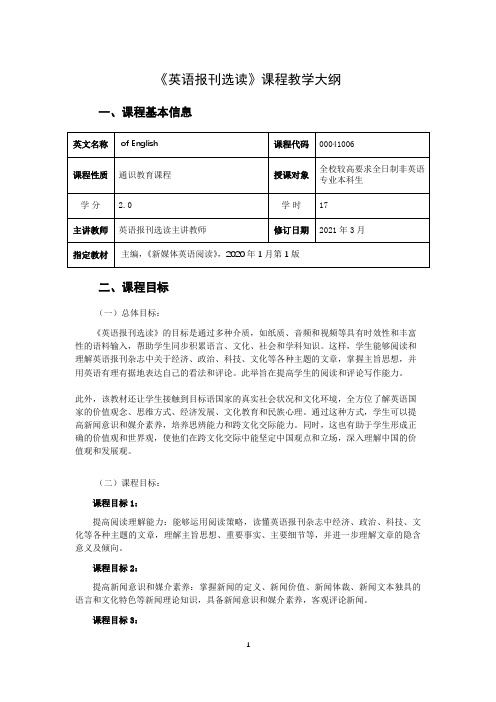
《英语报刊选读》课程教学大纲一、课程基本信息二、课程目标(一)总体目标:《英语报刊选读》的目标是通过多种介质,如纸质、音频和视频等具有时效性和丰富性的语料输入,帮助学生同步积累语言、文化、社会和学科知识。
这样,学生能够阅读和理解英语报刊杂志中关于经济、政治、科技、文化等各种主题的文章,掌握主旨思想,并用英语有理有据地表达自己的看法和评论。
此举旨在提高学生的阅读和评论写作能力。
此外,该教材还让学生接触到目标语国家的真实社会状况和文化环境,全方位了解英语国家的价值观念、思维方式、经济发展、文化教育和民族心理。
通过这种方式,学生可以提高新闻意识和媒介素养,培养思辨能力和跨文化交际能力。
同时,这也有助于学生形成正确的价值观和世界观,使他们在跨文化交际中能坚定中国观点和立场,深入理解中国的价值观和发展观。
(二)课程目标:课程目标1:提高阅读理解能力:能够运用阅读策略,读懂英语报刊杂志中经济、政治、科技、文化等各种主题的文章,理解主旨思想、重要事实、主要细节等,并进一步理解文章的隐含意义及倾向。
课程目标2:提高新闻意识和媒介素养:掌握新闻的定义、新闻价值、新闻体裁、新闻文本独具的语言和文化特色等新闻理论知识,具备新闻意识和媒介素养,客观评论新闻。
课程目标3:培养思辨和跨文化交际能力:提升信息搜集和分析的能力,理解全球各国的交际礼仪、审美趣味、思维方式、价值观和意识形态。
这将帮助我们客观地认识中国与世界,形成正确的价值观和世界观。
在跨文化交际中,我们应坚定维护中国观点和立场,用英语阐述中国的内涵和价值。
课程目标4:提高评论写作能力:能就英语报刊中的常见话题发表自己的看法和评论,字数在300字以上,观点明确,语句通顺,条理清晰,论证严密,有理有据。
(三)课程目标与毕业要求、课程内容的对应关系三、教学内容课程导读1.教学目标1)让学生了解熟悉世界主流英语媒体及国内权威英语媒体资源2)使学生掌握基础的新闻理论知识3)帮助学生培养媒体素养,使学生能够多角度理解并客观评论新闻2.教学重难点培养学生的媒介素养,使学生认识到西方媒体报道的特点,强调中国媒体报道世界的中国视角和中国观点3.教学内容1)课程资源介绍,包括主要的英语媒体资源,重点介绍国内的权威英语媒体资源2)新闻理论知识讲解,包括新闻的定义、价值、体裁、语言特色及文化特色等3)媒介素养培养,介绍西方媒体报道新闻、特别使中国新闻的特调,强调中国媒体报道新闻的视角和观点第一单元Education1.教学目标1)使学生掌握“教育”主题常用的词汇和句型2)使学生掌握Text A的主旨、结构、事实细节3)使学生掌握词义猜测第一部分的阅读策略4)通过其他课内外材料的阅读,对“教育”相关主题形成自己的看法2.教学重难点通过文字、音频、视频等多种材料的自学及课堂教学,让学生充分了解“教育”相关主题的信息,形成自己的观点和看法3.教学内容1“教育”主题新闻播报2Text A背景知识、课文主旨、结构的讲解分析3学术阅读策略1的学习和训练4“教育”相关主题的课堂讨论第二单元Culture and Society1.教学目标1 使学生掌握“文化与社会”主题常用的词汇和句型2 使学生掌握Text A的主旨、结构、事实细节3 使学生掌握词义猜测第二部分的阅读策略4 通过其他课内外材料的阅读,对“文化与社会”相关主题形成自己的看法2.教学重难点通过文字、音频、视频等多种材料的自学及课堂教学,让学生充分了解“文化与社会”相关主题的信息,形成自己的观点和看法3.教学内容1“文化与社会”主题新闻播报2Text A背景知识、课文主旨、结构的讲解分析3学术阅读策略2的学习和训练4“文化与社会”相关主题的课堂讨论第三单元Politics1.教学目标1 使学生掌握“政治”主题常用的词汇和句型2 使学生掌握Text A的主旨、结构、事实细节3 使学生掌握定位中心句和重要细节这一阅读策略4 通过其他课内外材料的阅读,对“政治”相关主题形成自己的看法2.教学重难点通过文字、音频、视频等多种材料的自学及课堂教学,让学生充分了解“政治”相关主题的信息,形成自己的观点和看法3.教学内容1“政治”主题新闻播报2Text A背景知识、课文主旨、结构的讲解分析3学术阅读策略3的学习和训练4“政治”相关主题的课堂讨论第四单元Economy1.教学目标1 使学生掌握“经济”主题常用的词汇和句型2 使学生掌握Text A的主旨、结构、事实细节3 使学生掌握判断文章结构这一阅读策略4 通过其他课内外材料的阅读,对“经济”相关主题形成自己的看法2.教学重难点通过文字、音频、视频等多种材料的自学及课堂教学,让学生充分了解“经济”相关主题的信息,形成自己的观点和看法3.教学内容1“经济”主题新闻播报2Text A背景知识、课文主旨、结构的讲解分析3学术阅读策略4的学习和训练4“经济”相关主题的课堂讨论第五单元Science and Technology1.教学目标1 使学生掌握“科技”主题常用的词汇和句型2 使学生掌握Text A的主旨、结构、事实细节3 使学生了解批判性思考的特点和在阅读中的重要性4 通过其他课内外材料的阅读,对“科技”相关主题形成自己的看法2.教学重难点通过文字、音频、视频等多种材料的自学及课堂教学,让学生充分了解“科技”相关主题的信息,形成自己的观点和看法3.教学内容1“科技”主题新闻播报2Text A背景知识、课文主旨、结构的讲解分析3学术阅读策略5的学习和训练4“科技”相关主题的课堂讨论四、学时分配表2:各章节的具体内容和学时分配表五、教学进度表3:教学进度表六、教材及参考书目1.张卓主编,《新媒体英语阅读》,苏州大学出版社,2020年1月第1版七、教学方法本课程专注于知识传授、价值引导和能力提升三个维度,将课程思政与主题学习、语言学习和技能学习紧密结合。
英语报刊选读-教学大纲
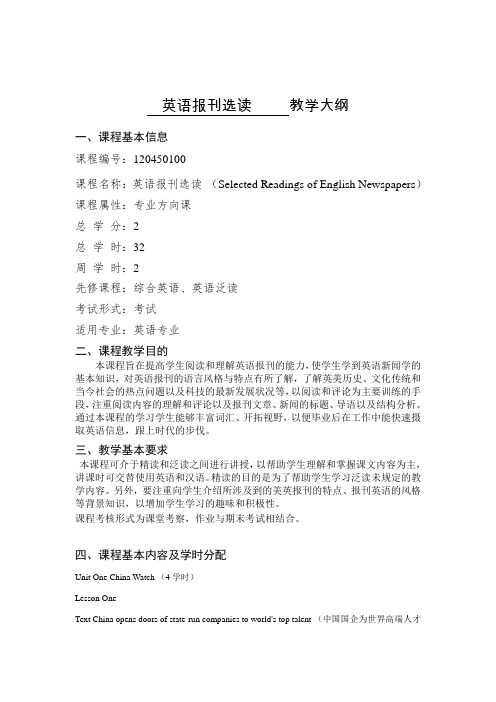
一、课程基本信息课程编号:120450100课程名称:英语报刊选读(Selected Readings of English Newspapers)课程属性:专业方向课总学分:2总学时:32周学时:2先修课程:综合英语、英语泛读考试形式:考试适用专业:英语专业二、课程教学目的本课程旨在提高学生阅读和理解英语报刊的能力,使学生学到英语新闻学的基本知识,对英语报刊的语言风格与特点有所了解,了解英美历史、文化传统和当今社会的热点问题以及科技的最新发展状况等,以阅读和评论为主要训练的手段,注重阅读内容的理解和评论以及报刊文章、新闻的标题、导语以及结构分析。
通过本课程的学习学生能够丰富词汇、开拓视野,以便毕业后在工作中能快速摄取英语信息,跟上时代的步伐。
三、教学基本要求本课程可介于精读和泛读之间进行讲授,以帮助学生理解和掌握课文内容为主,讲课时可交替使用英语和汉语。
精读的目的是为了帮助学生学习泛读未规定的教学内容。
另外,要注重向学生介绍所涉及到的美英报刊的特点、报刊英语的风格等背景知识,以增加学生学习的趣味和积极性。
课程考核形式为课堂考察,作业与期末考试相结合。
四、课程基本内容及学时分配Unit One China Watch (4学时)Lesson OneText China opens doors of state-run companies to world's top talent (中国国企为世界高端人才敞开大门)(The Washington Post, November 16, 2011)新闻写作何谓NewsLesson TwoText An American in Beijing(中国经济迅猛发展,留学生蜂拥而至)(Time, April 4,2008)语言解说 PresenceLesson ThreeText Tiger Mom ... Meet Panda Dad(熊猫爸爸挑战虎妈育儿经)(The Wall Street Journal, March 29,2011)新闻写作新闻体裁Unit Two United States (Ⅰ)(4学时)Lesson FourText Is an Ivy League Diploma Worth It?(上常春藤名校,值吗?)(The Wall Street Journal, November 8,2011)读报知识 Ivy League & Seven Sisters CollegesLesson FiveText Debt Burden Alters Outlook for US Graduates(求学负债:美国毕业生前景堪忧)(The Financial Times, June 1,2012)学习方法读懂标题(I)Lesson SixText The Evolution Wars(进化论与上帝造人说之争)(Time, August 15, 2005)读报知识宗教Unit Three United States (Ⅱ)(4学时)Lesson SevenText Obama Wins a Second Term as U.S. President(奥巴马连任总统:任重道远)(The Washington Post, November 7,2012)读报知识美国总统选举Lesson EightText The Economy Sucks. But Is It' 92 Redux?(经济不振,难道08年大选是92年的翻版吗?)(Newsweek, January 21, 2008)语言解说 Stupid和Technical(ly)Lesson NineText Five myths about the American dream(对美国梦的种种困感)(The Washington Post, Jan 6,2012)新闻写作导语(Lead)Lesson TenText Is America-s new declinism for real?(美国是真的衰落了吗?)(Financial Times, November 24, 2008)语言解说 EstablishmentUnit Four United States(Ⅲ)(4学时)Unit Five Britain (4学时)Unit Six The World (4学时)Unit Seven Society (4学时)Unit Eight Business and Science (2学时)Unit Nine Sports and Entertainment(2学时)五、教材及主要参考书目郭影平《最新报刊英语阅读》东南大学出版社 2010马建国《英文报刊导读》,外语教学与研究出版社,2002周学艺《英美报刊文章选读(精选本)》,北京大学出版社1997周学艺《英美报刊文章选读(精选本)学习辅导》,北京大学出版社1997端木义万,《英美报刊阅读教程》南京大学出版社,1997。
英语报刊选读考试样题(2)

英语报刊选读考试样题(2)
英语报纸和杂志是学习英语的重要资源。
它们为读者提供了丰富多样的信息和观点,帮助人们提高英语阅读和理解能力。
在这篇文章中,我将介绍一些英语报刊选读考试的样题。
英语报刊选读考试的样题通常包括阅读理解和相关的练习题。
这些题目旨在测试考生对英语文章的理解和分析能力,以及对语法和词汇的运用。
一个阅读理解样题可以是一篇短文或一篇有关某个话题的文章。
考生需要仔细阅读文章,并回答一些与文章内容相关的问题。
这些问题可能涉及主旨、细节、推理、隐含意义等方面。
考生需要基于对文章的理解和推理,选择正确的答案。
另一个样题可能要求考生根据某个句子的上下文,选择合适的词或短语填空。
这样的题目旨在考察考生对词汇和语法的掌握。
考生需要根据上下文的意思和句子的语法结构,选择最合适的选项来填空。
有些样题要求考生对文章中的观点或论据进行分析和评价。
考生需要根据自己的理解和观点,回答相关的问题。
这些题目旨在帮助考生培养批判性思维和分析问题的能力。
在备考英语报刊选读考试时,考生应该多读英语文章,特别是和考试中常见话题相关的文章。
可以通过阅读英语报纸和杂志,或使用在线学习资源来进行训练。
此外,考生还应该多做一些练习题,加强对文章的理解和分析能力。
总之,英语报刊选读考试是一个测试考生对英语文章理解和分析能力的重要环节。
通过多读英语文章和做练习题,考生可以提高自己的阅读和理解能力,为考试做好准备。
英语报刊选读
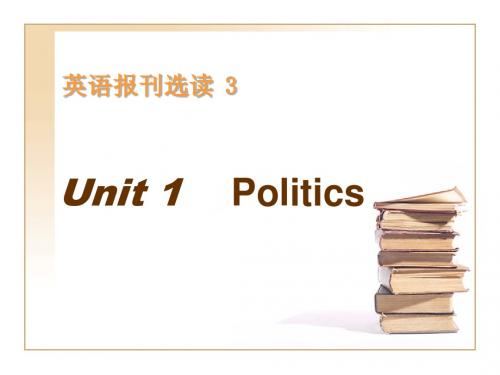
summer
the presidential early Sept. campaign popular vote election day (Nov.)
Principles
• Electoral Collystem “胜者全得”制度
Text reading
• Title and subtitle • Para.1- 4 • Para.27-32 opening closing
• Understanding questions • Get into the mind of the author!
1. 2. 3. 4.
Lobbying Who is Jerry Lewis? Congress President Bush’s fiscal 2005 budget proposal 5. K street firms 6. How did universities lobby?
• “The difference between USA Today and the rest of the industry was evident from the first day, Sept. 15, 1982.”
• “There’s still a wide spread between what other major newspapers look like and read like, and USA Today, but it’s not as wide as it was,” said Allen H. Neuharth, the former Gannett chairman and chief executive who created USA Today.
英文报刊选读
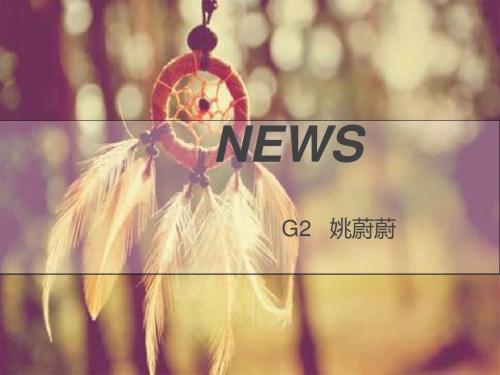
Q: Who plays an important role in unpaid intles target for profit colleges
WASHINGTON — The Obama administration will release new regulations on Friday requiring most for-profit and career — or vocational — colleges to demonstrate that they are properly preparing students for careers after graduation or face being barred from 被禁止federal student aid programs. Students at for-profit colleges represent about 13% of the total higher education population, but a disproportionate [,dɪsprə'pɔːʃ(ə)nət],不成比例的number of federal student loans — about 31% of all loans --go to such schools, which are popular with adult students and veterans['vet(ə)r(ə)n],富有经验的人,老兵 trying to launch careers. Nearly half of all college loan defaults are from students enrolled in such programs.
新编英语报刊选读
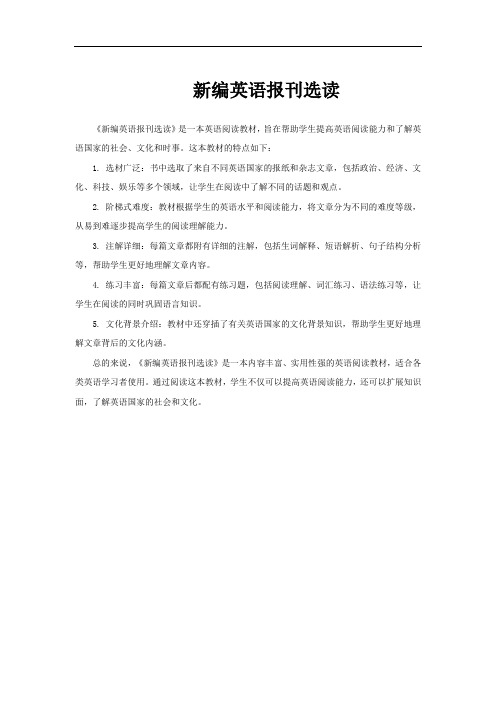
新编英语报刊选读
《新编英语报刊选读》是一本英语阅读教材,旨在帮助学生提高英语阅读能力和了解英语国家的社会、文化和时事。
这本教材的特点如下:
1. 选材广泛:书中选取了来自不同英语国家的报纸和杂志文章,包括政治、经济、文化、科技、娱乐等多个领域,让学生在阅读中了解不同的话题和观点。
2. 阶梯式难度:教材根据学生的英语水平和阅读能力,将文章分为不同的难度等级,从易到难逐步提高学生的阅读理解能力。
3. 注解详细:每篇文章都附有详细的注解,包括生词解释、短语解析、句子结构分析等,帮助学生更好地理解文章内容。
4. 练习丰富:每篇文章后都配有练习题,包括阅读理解、词汇练习、语法练习等,让学生在阅读的同时巩固语言知识。
5. 文化背景介绍:教材中还穿插了有关英语国家的文化背景知识,帮助学生更好地理解文章背后的文化内涵。
总的来说,《新编英语报刊选读》是一本内容丰富、实用性强的英语阅读教材,适合各类英语学习者使用。
通过阅读这本教材,学生不仅可以提高英语阅读能力,还可以扩展知识面,了解英语国家的社会和文化。
32-英语报刊选读
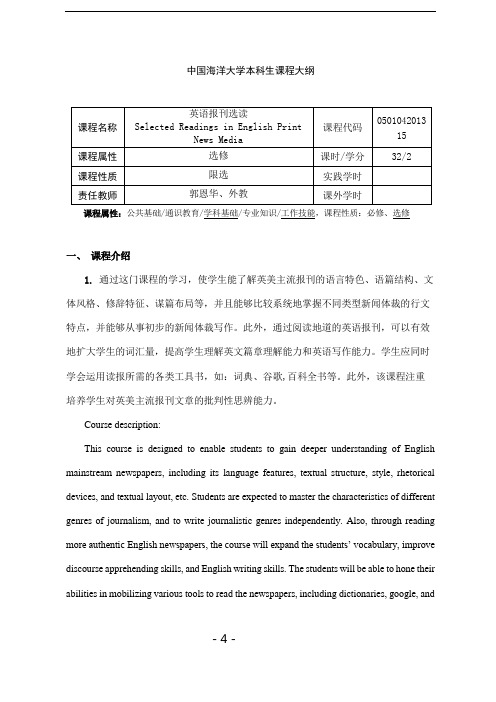
中国海洋大学本科生课程大纲课程属性:公共基础/通识教育/学科基础/专业知识/工作技能,课程性质:必修、选修一、课程介绍1.通过这门课程的学习,使学生能了解英美主流报刊的语言特色、语篇结构、文体风格、修辞特征、谋篇布局等,并且能够比较系统地掌握不同类型新闻体裁的行文特点,并能够从事初步的新闻体裁写作。
此外,通过阅读地道的英语报刊,可以有效地扩大学生的词汇量,提高学生理解英文篇章理解能力和英语写作能力。
学生应同时学会运用读报所需的各类工具书,如:词典、谷歌,百科全书等。
此外,该课程注重培养学生对英美主流报刊文章的批判性思辨能力。
Course description:This course is designed to enable students to gain deeper understanding of English mainstream newspapers, including its language features, textual structure, style, rhetorical devices, and textual layout, etc. Students are expected to master the characteristics of different genres of journalism, and to write journalistic genres independently. Also, through reading more authentic English newspapers, the course will expand the students’ vocabulary, i mprove discourse apprehending skills, and English writing skills. The students will be able to hone their abilities in mobilizing various tools to read the newspapers, including dictionaries, google, and- 4 -encyclopedia, etc. They are also expected to form critical thinking skills with regard to English newspapers.2.设计思路:课程素材选择主要考虑了以下几个设计思路:(1)要从学生的实际英语水平出发,难易适中,最好是i+1。
英语报刊选读课程简介

英语报刊选读课程简介课程编号:课程名称:英语报刊选读学分:2学时:32考核形式:考查适用专业:非英语专业(大学英语四级水平及以上)内容简介:英语报刊选读课的教学目的旨在提高大学生阅读和理解英语报刊的能力,使学生学到大众传媒和英语新闻学的基本知识,对英语报刊的语言风格与特色有所了解,了解英美历史、文化传统和当今社会的热点问题以及科技的最新发展状况等,以阅读和评论为主要训练的目的,注重阅读内容的理解和评论,词汇背景知识的掌握,以及报刊文章、新闻的标题、导语以及结构分析。
通过本课程的学习学生能够丰富词汇、发展兴趣、开拓视野,以便毕业后在工作中能快速摄取英语信息,跟上时代的步伐,成为具有国际视野的复合型人才。
同时本课程的教学注重培养学生分析与综合、抽象与概括、多角度分析问题等多种思维能力以及发现问题、解决难题等创新能力。
本课程的选材遵循时事新闻和专题报导相结合的原则,每个教学单元包括:背景(介绍专题的历史、背景、新动向及前景);注释(针对选定文章中的词汇、习语、语法、文化知识的难点及对选定文章的理解给予解释)。
选材来源分为两类:一类选自报刊、互连网(文字和视频)的报导、评论;另一类选自指定教材;讨论题(重点放在对专题及课文的理解)。
教学特点:本课程要求具备的教学条件为多媒体教室。
通过多媒体辅助教学,培养学生的多元识读能力。
授课方式采用专题讲座和章节学习相结合的方式进行,使学生不但提高对外刊的阅读能力,而且掌握大众传媒和英语新闻学的基本知识。
语篇分析教学法:通过语篇分析使学生掌握报刊新闻报道在宏观语篇结构、语法和用词上的特点。
注重导学、助学,通过小组讨论、课堂陈述等方式最大限度地发挥学生的主观能动性。
学习方式:①自主学习:突出对学生自主学习能力、学习策略的培养。
网络课程的建设和日臻完善为学生自主学习提供了良好的助学平台。
毕博网络教学平台为学生的自主学习提供了如下便利:下载相关的教学资源;进入网络自主考试系统进行自我测试;观看和收听和主题相关的时事新闻报道等等。
英语报刊选读

英语报刊选读Selective Readings in English Print News Media一、基本信息课程代码:2020126课程学分:2面向专业:英语课程性质:专业任意选修课课程类型:理论教学课开课院系:外国语学院英语系使用教材:主教材《英语报刊选读》,张卫平主编,外研社,2011先修课程:《英语阅读(1-4)》;《高级英语(1)》并修课程:《高级英语(2)》后续课程:《高级英语(3)》二、课程简介本课程适应新时期培养高素质复合型人才的需要,针对学生未来的考研和职业需求,突出对外报外刊分析、总结、归纳和研究能力的培养,提高学生观察、理解、分析问题的能力和独立思考的能力,进一步提高学生的阅读理解能力和英语口、笔头表述能力。
本课程阅读的材料主要选自英国、美国出版的报纸和刊物,文章的类型以社论、时事评论、新闻分析为主,时事新闻为辅。
通过课程学习,学生将会了解一些主要英美报刊的特点、报刊英语风格等,学习现代实用、丰富鲜活的英语,既提高语言运用能力,又从报刊中获取信息,了解西方动态,扩大有关政治、经济、科技、军事及社会文化等方面的词汇及知识面,为独立阅读各种英语材料打下良好的基础。
三、选课建议本课程为英语本科三年级下学期学生开设,要求学生有8000左右英语词汇量和专业四级的阅读能力。
四、课程基本要求通过基本的传媒理论学习及报刊阅读技巧的培训,使学生能够较为熟练地阅读一般性的英文报纸和杂志。
五、课程内容第一单元:知道美国政治中的“院外游说”现象和美国总统大选;理解《大学为保护资金利益而大肆游说》的报道。
第二单元:理解课文,知道英语汽车词汇和美国航天工业的基本情况。
第四单元:理解课文,知道美国文化产品中的分级制度和美国的死刑制度。
第五单元:理解课文,知道美国的教育体制状况和美国的著名大学概况。
第六单元:理解课文,知道美国时尚文化的四大先锋和美国习俗。
第七单元:理解课文,知道美国人的娱乐方式和法国的印象主义。
英语报刊选读教程

英语报刊选读教程
《英语报刊选读教程》是一本旨在帮助学生提高阅读和理解英语报刊能力的教材。
以下是该教程可能包含的一些主要内容:
1. 新闻英语基础知识:该部分将介绍新闻英语的基本要素,包括标题、导语、正文等。
此外,还将介绍新闻英语的特点和风格,以及新闻英语的语法和词汇。
2. 不同类型新闻的阅读理解:该部分将介绍不同类型的新闻报道,例如政治、经济、社会、体育等,并引导学生理解不同类型新闻报道的特点和写作风格。
3. 英语报刊选读技巧:该部分将介绍一些阅读英语报刊的技巧,例如如何快速浏览文章、如何抓住文章重点等。
此外,还将引导学生学习如何从文章中获取信息,并将其应用于实际生活中。
4. 英语报刊选读实践:该部分将提供一些英语报刊选读实践练习,例如阅读理解练习、词汇练习等。
通过这些练习,学生可以巩固所学知识,提高阅读理解能力。
总的来说,《英语报刊选读教程》是一本实用的教材,可以帮助学生们提高阅读和理解英语报刊的能力。
同时,该教材还可以帮助学生了解英语国家的文化和价值观,拓宽视野。
英语报刊选读

英语报刊选读一、阅读材料1. The Economist (经济学人)The Economist is a weekly international business magazine published in London. It provides objective reporting, analysis and opinion to help business people and policy makers understand the global economy. The magazine covers a wide range of topics including business, politics, technology, culture and international affairs. It is a good source of news and analysis for English learners.2. New York Times (纽约时报)The New York Times is a daily newspaper published in New York City. It is one of the most influential English-language newspapers in the world, covering news, culture, sports and other topics. The newspaper publishes high-quality reporting, analysis and opinion on current events, and it is a good source of reading practice for English learners.3. Wall Street Journal (华尔街日报)The Wall Street Journal is a daily business newspaper published in New York City. It provides objective reporting and analysis on the financial markets, business news, economics and other topics. The newspaper is written in a formal style and is a good choice for students who want to improve their writing skills.二、回答问题1. What are the main differences between The Economist and the New York Times?The Economist is a weekly international business magazine published in London, providing objective reporting, analysis and opinion to help business people and policy makers understand the global economy. The New York Times is a daily newspaper published in New York City, covering news, culture, sports and other topics. Therefore, The Economist is more focused on business and international affairs, while the New York Times covers a wider range of topics.2. What are the advantages of reading Wall Street Journal for English learners?Reading the Wall Street Journal has several advantages for English learners. Firstly, it provides objective reporting and analysis on the financial markets, business news, economics and other topics, which helps learners improve their understanding of financial and economic issues. Secondly, the newspaper is written in a formal style, which provides learners with opportunities to improve their writing skills. Finally, reading the Wall Street Journal is a good source of reading practice for learners who want to improve their reading comprehension and vocabulary skills.三、个人观点In my opinion, reading English newspapers and magazines is an effective way for English learners to improve their language proficiency. By reading different types of newspapers and magazines, learners can broaden their horizons, improve their writing skills, and gain a better understanding of current events and international affairs. Additionally, reading newspapers and magazines in a foreign language provides learners with opportunities to practice their reading, listening, speaking and writing skills, which helps them develop a more natural fluency in the target language. Therefore, I recommend that English learners regularly read English newspapers and magazines to improve their language proficiency.。
unit 1 英语报刊选读

Memorization of vocabulary lists Reading texts Fluency and conversation classes Having a nativespeaking teacher Learning grammar rules
Watching videos and listening to cassettes Meeting with Englishspeaking people Having a non-nativespeaking teacher
Answer the following questions after reading the news.
1. 2. 3.
4.
5.
What problem did Kim Hyo Jin have? Who funds the English village? Why is Korea so “aggressive” when it comes to encouraging students to speak English? What happens in the English village if students speak Korea? What do Korean delegates do at international conferences?
She was a great athlete but she ________ at the last hurdle and fell. What a fool! He got drunk and just ______ the secret! He hated living with his new foster parents and he ______ from home. He spends all evening ________ on MSN Messenger. They finally __________ that old warehouse on Silver Street- it just had to go!
英语报刊选读参考答案.
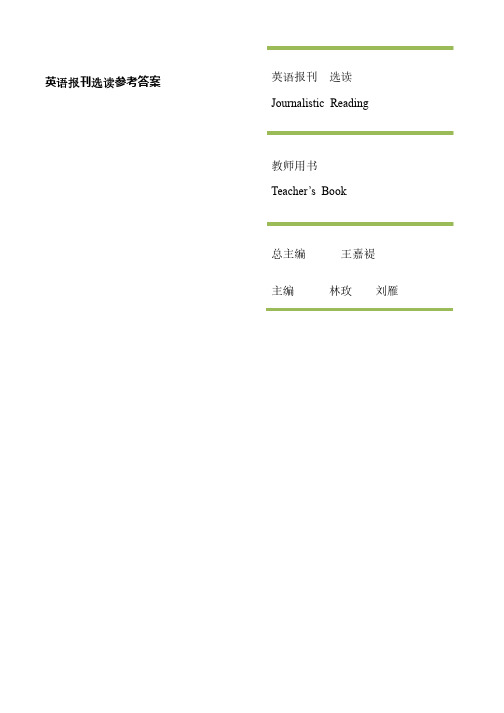
英语报刊选读参考答案英语报刊选读Journalistic Reading 教师用书Teacher’s Book总主编王嘉褆主编林玫刘雁BOOK ONE (2)UNIT 1 Campus (2)UNIT 2 Entertainment .............................................................................................. 5 5 UNIT 3 Entertainment .............................................................................................. 9 9 UNIT 4 Food . (12)UNIT 5 Crime (15)UNIT 6 Disaster (19)UNIT 7 Sports (23)UNIT 8 Art (28)UNIT 9 Economy (31)UNIT 10 Ecology (36)UNIT 11 Health (39)UNIT12 Automobile & Driving (43)UNIT 13 Quality problems (48)UNIT 14 Shopping (52)UNIT 15 Gun control (56)UNIT 16 Psychology (59)BOOK ONEUNIT 1 Campus I . Vocabulary Builder 1. Definition1) chaotic : extremely disorganized; badly organized; be in mess 2) primary : main; most important; key; major; chief; prime; principal 3) seduce : attract; tempt 4) highlight : the most important, interesting, or enjoyable part of something such as a holiday, performance, or sports competition 5) reluctant : unwilling 6) compelling : : very very very interesting interesting interesting or or or exciting, exciting, exciting, so so so that that that you you you have have have to to to pay pay attention 7) reveal : show; indicate 8) mainstream : : accepted accepted accepted by by by or or or involving involving involving most most most people people people in in in a a a society; society; normal; ordinary 9) critical: important; crucial 10) evolution : a long, gradual process during which something develops and changes, usually becoming more advanced; a gradual change and development 2. Terms translation 1) a bipartisan consensus 2)high school diploma 3)drop-out rate 4)college wage premium 5)the K-12 system 6)more academically rigorous 7)well-rounded citizens 8)certification tests 9)career and technical education 3. Blank filling1) persevered 2) persisted 3) insisted 4) insisted 5) persevere 6) agony 7) adversity 8) torment 9) plight 10) assure/reassure 11) insure/ensure 12) insure 13) insure/ensure 14) assured/reassured II.Translation1.选择圣路易斯的华盛顿大学是个不错的决定,但真正让我享受到理想大学生活的,(不是大学本身)是我到了大学后作的一些决定。
英语报刊选读教学大纲(最新完整版)

英语报刊选读教学大纲(最新完整版)英语报刊选读教学大纲教学大纲是阐述教学内容和教学方法的指导性文件,由学校或教育行政部门统一制定。
以下是英语报刊选读教学大纲:一、课程基本信息英语报刊选读是一门旨在培养学生阅读英语报刊*能力的课程。
通过学习本课程,学生将掌握阅读英语报刊*的基本技巧和方法,提高阅读速度和阅读理解能力,培养国际视野和跨文化交流能力。
二、课程目标1.提高学生的英语阅读速度和阅读理解能力,能够快速、准确地阅读英语报刊*。
2.培养学生的跨文化交流能力,了解不同国家的文化背景和价值观,提高跨文化交际能力。
3.拓宽学生的国际视野,了解国际政治、经济、文化等方面的新闻和热点话题,培养国际意识。
4.提高学生的自主学习能力,培养自主阅读、自主学习的习惯和能力。
三、教学内容1.报刊*阅读技巧和方法:介绍英语报刊*的基本结构和特点,讲解如何快速、准确地阅读英语报刊*。
2.新闻报道文体特点:介绍新闻报道的文体特点,包括新闻标题、导语、主体、结尾等部分的特点和作用。
3.热点话题:选取国际政治、经济、文化等方面的热点话题,介绍相关背景知识和*选读,培养学生的国际视野和跨文化交流能力。
4.自主学习:提供相关英语报刊*和阅读材料,供学生自主学习和拓展阅读。
四、教学方法1.课堂讲解:通过课堂讲解,传授报刊*阅读技巧和方法,分析新闻报道文体特点,讲解热点话题相关知识。
2.自主学习:提供相关英语报刊*和阅读材料,供学生自主学习和拓展阅读。
3.小组讨论:组织小组讨论,让学生分享阅读心得和体会,交流阅读方法和技巧。
4.课堂互动:鼓励学生积极参与课堂互动,提问、回答问题、发表观点,提高学生的口语表达能力和思辨能力。
五、教学评估1.平时作业:布置相关作业,包括阅读理解题、翻译题、写作题等,检测学生的阅读理解能力和语言表达能力。
2.期末考试:组织期末考试,检测学生对本课程知识的掌握程度和应用能力。
英语泛读教学大纲《普通高中英语课程标准(2017年版)》(以下简称《新课标》)设置了"读"的学业质量标准,其中包括了"英语泛读"的要求。
英语报刊选读(第一册)参考答案

BOOK ONE ............................................................................................................................................... 2 UNIT 1 Campus ............................................................................................................................................. 2 UNIT 2 Entertainment .................................................................................................................................. 3 UNIT 3 Entertainment .................................................................................................................................. 5 UNIT 4 Food .................................................................................................................................................. 6 UNIT 5 Crime ................................................................................................................................................ 8 UNIT 6 Disaster ........................................................................................................................................... 10 UNIT 7 Sports .............................................................................................................................................. 12 UNIT 8 Art ................................................................................................................................................... 14 UNIT 9 Economy ......................................................................................................................................... 16 UNIT 10 Ecology (18)UNIT 11 Health (19)UNIT12 Automobile & Driving .................................................................................................................... 21 UNIT 13 Quality problems .......................................................................................................................... 23 UNIT 14 Shopping ....................................................................................................................................... 25 UNIT 15 Gun control ................................................................................................................................... 27 UNIT 16 Psychology (29)英语报刊 选读Journalistic Reading教师用书 Teacher ’s Book总主编 王嘉褆主编 林玫 刘雁BOOK ONEUNIT 1 CampusI.Vocabulary Builder1.Definition1)chaotic: extremely disorganized; badly organized; be in mess2)primary: main; most important; key; major; chief; prime; principal3)seduce: attract; tempt4)highlight: the most important, interesting, or enjoyable part of something such as a holiday,performance, or sports competition5)reluctant: unwilling6)compelling: very interesting or exciting, so that you have to pay attention7)reveal: show; indicate8)mainstream: accepted by or involving most people in a society; normal; ordinary9)critical: important; crucial10)evolution: a long, gradual process during which something develops and changes, usuallybecoming more advanced; a gradual change and development2. Terms translation1) a bipartisan consensus2)high school diploma3)drop-out rate4)college wage premium5)the K-12 system6)more academically rigorous7)well-rounded citizens8)certification tests9)career and technical education3. Blank filling1) persevered 2) persisted 3) insisted 4) insisted 5) persevere6) agony 7) adversity 8) torment 9) plight 10) assure/reassure11) insure/ensure 12) insure 13) insure/ensure 14) assured/reassured II.Translation1.2.选择圣路易斯的华盛顿大学是个不错的决定,但真正让我享受到理想大学生活的,(不是大学本身)是我到了大学后作的一些决定。
《英语报刊选读》大纲
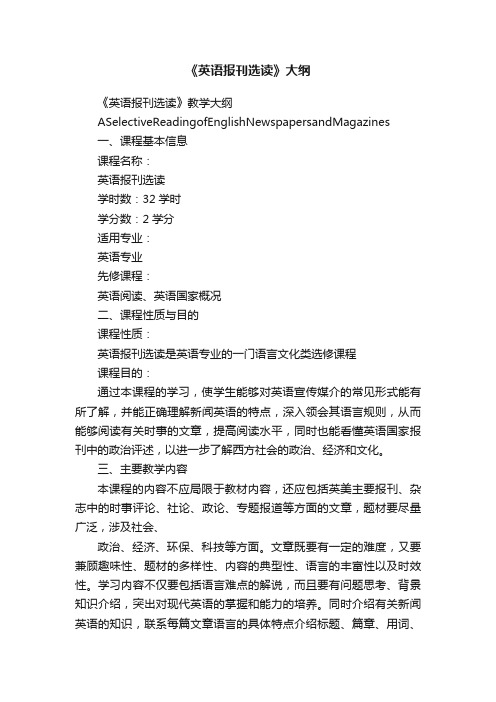
《英语报刊选读》大纲《英语报刊选读》教学大纲ASelectiveReadingofEnglishNewspapersandMagazines一、课程基本信息课程名称:英语报刊选读学时数:32学时学分数:2学分适用专业:英语专业先修课程:英语阅读、英语国家概况二、课程性质与目的课程性质:英语报刊选读是英语专业的一门语言文化类选修课程课程目的:通过本课程的学习,使学生能够对英语宣传媒介的常见形式能有所了解,并能正确理解新闻英语的特点,深入领会其语言规则,从而能够阅读有关时事的文章,提高阅读水平,同时也能看懂英语国家报刊中的政治评述,以进一步了解西方社会的政治、经济和文化。
三、主要教学内容本课程的内容不应局限于教材内容,还应包括英美主要报刊、杂志中的时事评论、社论、政论、专题报道等方面的文章,题材要尽量广泛,涉及社会、政治、经济、环保、科技等方面。
文章既要有一定的难度,又要兼顾趣味性、题材的多样性、内容的典型性、语言的丰富性以及时效性。
学习内容不仅要包括语言难点的解说,而且要有问题思考、背景知识介绍,突出对现代英语的掌握和能力的培养。
同时介绍有关新闻英语的知识,联系每篇文章语言的具体特点介绍标题、篇章、用词、句法、修辞和文体等各个方面。
确保学生深入理解,提高学生的应用能力。
四、教学时数分配本课程开设一个学期,共32学时,学时建议分配如下:主要章节学时建议第二章新闻英语的词汇与语法4第三章标题的写法与种类4第四章导言的写法与种类2第五章新闻报道正文2第六章专题报道4第七章社论版和专栏版4第八章英语新闻阅读8.1政治篇8.2金融篇8.3社会篇8.4科技篇22228.5娱乐篇五、教学基本要求与教学方式基本要求:21.熟悉英美报刊文章的一般特点,掌握阅读英语报刊的技巧;2.了解英语报刊的语言特色、新闻报道的内容结构以及现代英语的发展现状;3.扩大知识面,加深对英美国家政治、经济、社会和文化等方面的认识。
教学方式:本课程可介于精读和泛读之间进行讲授,以帮助学生理解和掌握课文内容为主,讲课时可交替使用英语和汉语。
- 1、下载文档前请自行甄别文档内容的完整性,平台不提供额外的编辑、内容补充、找答案等附加服务。
- 2、"仅部分预览"的文档,不可在线预览部分如存在完整性等问题,可反馈申请退款(可完整预览的文档不适用该条件!)。
- 3、如文档侵犯您的权益,请联系客服反馈,我们会尽快为您处理(人工客服工作时间:9:00-18:30)。
*Shanxi to invest Large Sums for Tourism
*13 die as crowded Van crosses M4 (died, crossed) M-motorway
D. 运用标点符号。
For example:
A --------?
*Shell to cut up to 2800 jobs (get rid of)
*Gulf Arab states to sign anti- terror pact next month (agreement)
Use abbreviations:
A person should not have to finish the article to understand it, just the first four or five paragraphs. Direct quotations do not include new information. They either support or simply add color and entertainment.
Structure of the news reporting:
Headlin Lead Elaboration Background Secondary material
Usually the Lead ----- or the first paragraph ---- contains the story’s main point and most critical factors. Therefore, it is important to read it carefully to get a basic idea what the story is about.
*Koreans: Grumpy Toward America
c. 用分号代替两层意思。 (semi-colon)
*Militants kill 29, weak peace shattered
d. 用单引号代替双引号。(question marks)
*U.S. ‘In the Dark’ on Bin Laden Note
What exactly is a lead? (1) The lead usually summarizes the entire story so that the readers can learn at a glance what the story is about.
1. What exactly is a headline?
The headline or head of a news story is the line of print appearing above an article, often in bold, large type that summarizes the story. It is usually the first thing we read. In theory the headline has two functions:
P.M.; IOC; grade; tech; gov’t; m.p.; JV; GM; CFO; dorm; prep; forex; L. America; N. Ireland…
*Shenzhen SEZ to host int’l Trade Meeting
*India PM signs non-aggression pact (use n. for adj. Even if it is not grammatically correct. India for Indian)
B -------?
*Ann and^Baby Are Well (her)
*Radio, TV Coverage Widening.
D -------?
a. 用逗号(comma)代替and, 这样可以省略字符。
*China, CIS States May Share Cables (中国与独联体国家合作开发光电通讯)
b. 用冒号(colon)表示所讲的话的出处,还可以代替系动词。
再:在印刷上,美报刊里的实义词,有的连虚词也一样用大写字母,而英国报刊的题目只是第一个字母大写。
3. 标题修辞
英语报刊的标题为了使语言生动有力,鲜明形象,引人注目,常常使用下列修辞手段,旨在造成声色效果,引起读者注意和兴趣。
A. 押韵 :标题写作常用头韵和尾韵。
* Needy or Greedy?
*Bankers ^Silent (keep)
*FBI questions bombing suspect (The FBI questioned a suspect in a bombing yesterday)
*New Bird Flu Cure this Spring (A new drug will cure bird influenza this spring)
2. Language of a Headline
Four points:
A. 由于篇幅有限,尽量用短小的词或缩略词,尽量省略, 如用名词代替形容词,等等。
B. 不影响达意的冠词,助动词,系动词,连词,代词,介词 被省略掉。、
C. 时态的用法简单,灵活。许多报纸用一般时态,除了经常描述的过去的事情。一般时态使题目显得生动,即刻,有趣。(freshness, immediacy, interesting, lively)
e. 用破折号表强调或引出说话者。(dash)
*Yeltsin in Hospital --------- Again
*Economy Grows Slowly As Unemployment Inflation Rise----- Economist (经济学家认为,失业率及通货膨胀加剧使经济增长缓慢)
The next three or four paragraphs of a news story ---- for example……. ----- usually give essential details of WHAT is happened, WHO is involved, WHEN, WHERE, HOW, WHY it happened. It also gives an immediate result of, or reaction to, the news itself and provides background information to help you understand it.
*U.S. widely ^disliked (is)
*Co-operation agreement ^signed (is)
*(A) Cold and Raining Day (is) Expected
C ------?
一般现在时表过去
不定式表将来
进行时表正在延续的动作
*China Daily Delegation flies to US (is leaving by plane)
*Rich Man, Poor Fan.
*Capital rich, Revenue Poor.
D. 双关:(pun).不少新闻周刊,尤其是《时代周刊》爱用双关语,使标题产生讽刺和诙谐作用。
*Woes of the Weakened Jock. (jog)
E: 典故。(allusion).报刊标题使用名著的书名,使语言明快犀利,生动活泼。
Unit Two : Headlines
How to become an efficient newspaper reader?
By understanding news’ story’s format and the theory behind it, you often can tell in less 30 seconds what the report is saying and whether it’s of interest to you.
*Young Wheelers, Big Dealers.
B. 比喻:以人们熟悉的事物去描绘,说明不熟悉或比较抽象的事物,使语言简明生动。标题常使用暗喻 (metaphor)
* House in Two Parts.
*Hookers getting the Hook.
C. 对仗(antithesis). 对仗可以使语言鲜明形象,从而加强表达力。
*Health Survey: New Yorkers Fitter, Slimmer
* Owen: Watch Me Get Better
*WTO chief: China a Responsible Country
*China Cooks: Master at Turning a Turnip into a Flower
*Communists Fear Split Germany Blame
(The Communists fear that they may be blamed for splitting Germany)
*News From Mice: Men Not Needed
(This one aims at being humorous. It’s only when you read the story that you understand why men are not needed)
First: it summarizes the story in a minimum number of words.
